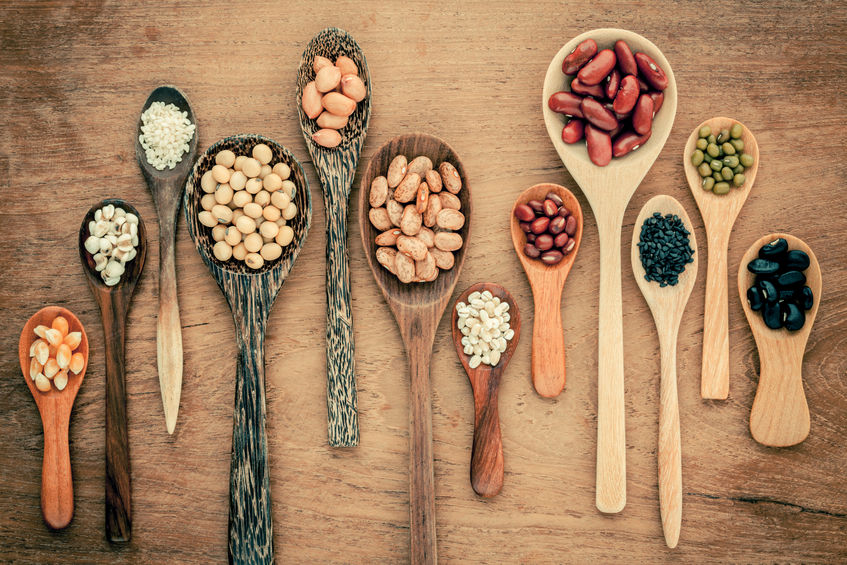The Year of Pulses
As of late, every time that I pull up my Facebook feed, I see an add telling me “eat your pulses.” Eat my what? I’d heard of pulses before, but if you asked me to give you a definition, I wouldn’t be able to. My inclination was that they’re some type of bean or legume. I decided to look into this and find out what pulses were and why I was supposed to eat them! Clearly, the creator of the advertisement felt that they had some nutritional benefit and I wanted to scope it out.
The USA Dry Pea and Lentil Council defines pulses as, “dry peas, dry beans, chickpeas (garbanzo beans), and lentils.”
How do pulses differ from legumes?
According to Academy of Nutrition and Dietetics spokesperson, Sara Haas, RDN, a legume is a plant whose fruit is enclosed in a pod. Pulses are members of the legume family. Pulses are legumes that are harvested for seeds. The seeds, once harvested, are dried (think a bag of raw, dry beans).
Based on the explanation of pulses, they’re not a new thing at all. So why am I suddenly being bombarded with a message to eat them every single time I open up Facebook? Have food scientists discovered a new benefit? Nutritionally, there aren’t new benefits, but that doesn’t mean there aren’t any benefits. Dietitians and other medical professionals have touted the benefits of beans/legumes for quite some time. In my article about vegans, I expressed that beans/legumes were a large source of plant-based protein in their diet. I’ll dig a bit deeper into the nutritional benefits later.

Pulses
But first, let’s tackle why suddenly pulses are in the spotlight.
Apparently, we’re living in the International Year of Pulses. The United Nations was so certain of the increasing popularity of pulses, that they gave 2016 that legendary title. The purpose was to increase awareness of their nutritional value, economic accessibility, role in food security, favorable environmental impact, and agricultural sustainability. More than just a nutritional powerhouse, pulses provide a sustainable means of food production. They come from plants that have nitrogen-fixing properties, which can contribute to increasing soil fertility and have a positive impact on the environment.
According to the Global Pulse Confederation (GPC), Pulse crops are one of the most sustainable crops a farmer can grow. To put things in perspective, it takes 216 gallons of water to produce one pound of soybeans , 368 gallons of water to produce one pound of peanuts and 1,857 gallons for one pound for beef. I love peanut butter and can easily go through a jar in a week if I’m not careful. Think about how often we consume products containing peanuts, the quantity of soy added to foods and the prevalence of burger restaurants! This is where pulses shine: It takes just 43 gallons of water to produce one pound of pulses. Talk about water conservation!
The GPC states that, “Though pulses are a very popular crop in the developing world, there is a massive gap in productivity between pulse crops inside and outside the developing world. With the introduction of improved varieties and promotion of better management techniques, pulse crops can continue to be an excellent choice for farmers in the developing world.”
Nutrition:
According to the United Nations’ Food and Agriculture Organization, pulses are a vital source of plant-based proteins and amino acids for people around the world. They recommend consuming pulses part of a healthful diet to address obesity, as well as to prevent and help manage chronic diseases such as diabetes, coronary conditions, and cancer. Protein isn’t the only benefit pulses provide. They also are a great source of fiber and micronutrients such as iron, folate, zinc, phosphorus and magnesium. In addition to providing an excellent plant based protein source for humans, they’re also an important source of plant-based protein for animals. The Global Pulse Confederation explained that up to 25% of pulses are used to feed pigs and poultry.
Pulses have played a large role in traditional foods from India, Pakistan, the Mediterranean region and the Middle East. Pulses add variety to menus and a chance for home cooks to expand their menu options. They are a great food to have on hand because, in addition to being easy to prepare, they also can serve as a meat extender on menus (ex: adding lentils or other beans to meatloaf, taco meat or soups to make the meal go further and provided filling fiber).
How should they be prepared?
Pulses are available in grocery stores in a variety of forms. The most common form is ready-to-use cans. If you purchased canned versions, look for “BPA Free” on the label and be sure to drain and rinse before consuming to reduce sodium intake. A more economical option is to purchase them dry in bulk containers or pre-bagged. Pulses should be cooked before eating. Unlike dry beans, lentils and split peas do not require soaking prior to cooking. Use unsalted water because adding salt may cause the lentils to toughen during cooking. If you plan on adding tomatoes, or other acidic ingredients, it is best to add them later in the cooking process because they may slow cooking. If you have a pressure cooker, you can make your own “refried beans” and freeze what you don’t consume for later use.
If you would like to help reduce your carbon food-print and assist agriculture sustainability, I suggest adding pulses to your diet a few times a week if not daily. Pulses would count as the complex carbohydrate in your meal in ½ cup cooked portions or in when consumed in 3/4th cup to 1 cup portions; they can serve as your sole protein source in a plant-based meal.
The following recipes from simplebites.net provide delicious ways to incorporate pulses into your diet.
Black Bean Hummus with Lime and Cumin
Try this healthy dip with raw vegetables or replace it with mayo or source cream on a sandwich or burrito.
Recipe type: Appetizer/Dip
Author: Katie Goodman
Serves/Yield: 4
Ingredients
- 1 – 15 ounce can black beans, drained and rinsed
- 1 clove garlic
- 2 1/2 tablespoons olive oil
- 2 tablespoons Tahini
- juice of 1/2 a lime
- 1/2 teaspoon cumin
- 1 teaspoon chili powder
- 1 – 2 tablespoons (packed) chopped fresh cilantro
- 1 – 2 tablespoons fire roasted diced green chiles, optional
- salt and pepper, to taste
Instructions
- Combine the black beans, tahini, lime juice, olive oil, garlic cloves, cumin, and chili powder into a food processor and blend until smooth.
- If additional liquid is needed to form desired consistency, add a tablespoon or two of water.
- Stir in the chopped cilantro and diced green chiles (if using). Season to taste with salt and pepper.
- Note: If you prefer a completely smooth hummus, you may blend the green chiles, if using, and cilantro with the other ingredients.
Coconut Curried Green Lentil Soup
Recipe type: Soup
Author: Aimee – adapted from Super Natural Every Day
Prep time: 20 mins
Cook time: 50 mins
Total time: 1 hour 10 mins
Ingredients
- 2 Tablespoons coconut oil (or unsalted butter)
- 1 Tablespoon good quality curry powder, freshly ground
- 2 teaspoons minced garlic
- 1 large sweet onion, chopped
- 5 cups of vegetable stockor water
- 1 1/2 cups green lentils, rinsed
- 1/2 cup coconut milk
- 1 teaspoon sea salt
Garnish options
- fresh chopped chives
- yogurt
- pinch of curry powder
Instructions
- Melt coconut oil in a large stockpot over medium-high heat, then add curry powder, garlic, and onion. Saute for about 3-4 minutes on medium heat, stirring often so the garlic doesn’t burn.
- Add vegetable stock and green lentils. Bring soup to a boil, then partially cover and reduce heat. Simmer for between 20 and 50 minutes (or until lentils are tender; mine typically take about 50 minutes).
- Once the lentils have finished cooking, remove soup from the heat and stir in the coconut milk and salt. Puree the soup using an immersion blender or regular blender (in batches if using regular blender) until it is as smooth or as chunky as you prefer.
- Serve immediately with your choice of garnish and a large salad.
If you’re feeling adventurous, try:
Black Bean Burgers
Author: Aimee – Adapted from The Everything Beans Book by Katie Kimball
Serves/Yield: 8 patties, 4” wide
The patties are very flavorful, but soft in texture. Creator, Aimee recommends adding plenty of ‘crunch’ to your burger to enjoy a balanced bite with lots of different textures. Options include: pickles, lettuce, sliced onion, sprouts, cucumber and salsa – although not all at once!
Ingredients
- 1 small onion, chopped
- 1/2 red pepper, chopped
- 1 Tablespoon olive oil
- 2 cloves garlic
- 1/4 cup fresh cilantro leaves
- (2 jalapenos, optional, seeded)
- 1/2 teaspoon ground cumin
- one can black beans, drained and rinsed
- 1 1/2 c. cooked green lentils (I used canned)
- 1 1/2 tsp. salt
- 1/2 tsp. pepper
- 2 eggs
- 1 c. bread crumbs (sub gluten free if necessary or rolled oats)
Instructions
- Open cans of black beans and brown or green lentils, rinse them well with cold water, and drain them in a small sieve.
- Heat olive oil in a small sauté pan. Roughly chop onion and red pepper; peel garlic. Sauté vegetables in the oil until they have softened, about five minutes. Remove from heat and allow to cool.
- Pulse the sautéed onion, pepper, garlic in a food processor, along with the fresh cilantro and optional jalepeno, until finely chopped. Add the beans and lentils and process until pasty. If your food processor is a bit weak, you may want to tackle this in two batches.(I only have a mini food processor, but I did it in three batches and was fine.)
- When mostly smooth, add salt, pepper, and the eggs. Process until combined and then add 3/4 of cup of bread crumbs and process briefly until incorporated. Give a little stir around the very center for anything your blade may have missed. If your food processor is on the small side, you may wish to remove the legume/vegetable mixture to a bowl and simply stir in the rest of the ingredients. (this is what I did!)
- Add more bread crumbs bit by bit until the mixture starts sticking together. It is now ready to form patties.
- Put some flour in a salad bowl to use in flouring your hands and the outside of the patties. Form 1/2- to 3/4-inch thick patties. The patties might seem a little fragile, but you don’t want them too stiff or they might dry out and get crumbly once cooked.
- Cook in a well-greased skillet over medium to medium-high heat, or an indoor grill, for about 5-8 minutes on each side, turning at least once for even doneness. You can add oil in between sides, especially if you want a nice even browning look, or if you’re using a cast iron skillet.
- Serve between two buns with an assortment of condiments and favorite toppings. Keep with the Mexican theme and offer fresh peppers, pickled jalapenos, avocado slices and salsa.
Freezer Tip: Patties can be layered between parchment paper in an airtight container and frozen for up to 6 weeks. To use: thaw in the refrigerator overnight, then grill or fry as usual.
Resources:
https://www.ag.ndsu.edu/pubs/yf/foods/fn1508.pdf
http://iyp2016.org/resources/what-are-pulses











